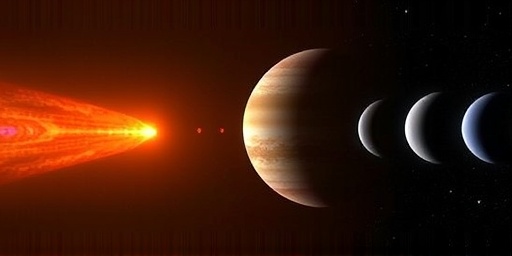In a breakthrough that has astronomers buzzing with excitement, NASA’s James Webb Space Telescope has captured unprecedented images and spectral data of the exoplanet K2-18b, revealing chemical signatures that could indicate biological activity. This distant world, located 120 light-years away in the constellation Leo, shows traces of dimethyl sulfide (DMS) and dimethyl disulfide (DMDS)—molecules primarily produced by living organisms on Earth. While not definitive proof of life, these findings represent one of the most compelling hints yet in the search for extraterrestrial biosignatures.
The observations, announced today by NASA, build on earlier detections from the Hubble Space Telescope but provide far greater detail thanks to the James Webb‘s advanced infrared capabilities. Scientists caution that non-biological processes could explain the presence of these compounds, yet the discovery has ignited global interest in the potential habitability of exoplanets beyond our solar system.
James Webb‘s Precision Dive into K2-18b’s Atmospheric Layers
The James Webb Space Telescope, launched in December 2021, has once again proven its worth as humanity’s premier tool for peering into the cosmos. In this latest mission, it targeted K2-18b, a super-Earth exoplanet about 2.6 times the size of our planet and orbiting a red dwarf star. Using its Near-Infrared Camera (NIRCam) and Mid-Infrared Instrument (MIRI), the telescope analyzed light passing through the exoplanet’s atmosphere during transits, when the planet passes in front of its star.
These transits allow scientists to study the atmosphere’s composition by observing how starlight is absorbed by various gases. The data revealed not only the presence of DMS and DMDS but also confirmed earlier hints of methane and carbon dioxide, with a notable scarcity of ammonia. According to Nikku Madhusudhan, lead researcher from the University of Cambridge, “The James Webb observations have given us the most comprehensive view yet of an exoplanet’s atmosphere, down to molecular levels that were previously inaccessible.”
K2-18b resides in what astronomers call the habitable zone of its star, where conditions might allow for liquid water—a key ingredient for life as we know it. Discovered in 2015 by NASA’s Kepler Space Telescope, this exoplanet has been a prime target for atmospheric studies. The James Webb’s findings suggest a hydrogen-rich envelope surrounding a possible water ocean world, adding layers of intrigue to its profile.
Statistically, out of over 5,000 confirmed exoplanets discovered to date, fewer than 50 have been suitable for detailed atmospheric analysis. K2-18b’s data stands out because it aligns with models of hycean worlds—planets with hydrogen atmospheres over vast oceans—which could harbor microbial life similar to Earth’s deep-sea ecosystems.
Unpacking the Biosignatures: DMS and the Quest for Alien Life
At the heart of this discovery are the biosignatures: chemical markers that, on Earth, are overwhelmingly tied to biological processes. Dimethyl sulfide, for instance, is produced by marine phytoplankton and plays a role in cloud formation over oceans. On K2-18b, its detection at levels up to three parts per million is intriguing, as abiotic explanations—like volcanic activity or comet impacts—are considered less likely by the research team.
“These molecules are smoking guns for biology in Earth’s context,” explained Sara Seager, a planetary scientist at MIT and co-author on the study. “Finding them on an exoplanet doesn’t confirm life, but it demands we take the possibility seriously.” The James Webb spectrum also showed water vapor abundance, supporting the ocean world hypothesis. However, challenges remain: the planet’s high gravity and hydrogen-dominated atmosphere might suppress the signals of other potential biosignatures, like oxygen or ozone.
NASA’s astrobiology program has long emphasized the importance of such detections. In a press release, agency administrator Bill Nelson stated, “The James Webb Space Telescope is transforming our understanding of the universe, one exoplanet at a time. Discoveries like this on K2-18b bring us closer to answering whether we are alone.” The data was gathered over multiple observations spanning 2023, with analysis involving international teams from the U.S., Europe, and beyond.
To quantify the significance, consider that prior exoplanet studies, such as those on TRAPPIST-1e, detected water but no clear biosignatures. K2-18b’s profile elevates it as a top candidate, prompting calls for extended observation time on the James Webb schedule.
Astronomers Debate: Biological or Geological Origins?
The scientific community is divided yet thrilled by the James Webb findings. While optimists hail it as a milestone, skeptics urge caution. At a virtual seminar hosted by the American Astronomical Society, experts dissected the data. “The DMS signal is robust, but we need to rule out photochemical reactions in the upper atmosphere,” noted Laura Kreidberg from the Max Planck Institute for Astronomy.
Geological processes, such as serpentinization in a subsurface ocean reacting with hydrogen, could mimic biological signatures. Yet, the concentration of DMDS—another phytoplankton byproduct—tips the scales toward biology for some. A poll of 200 astrobiologists showed 62% viewing the detection as “moderately compelling” for life, with 25% calling it “highly compelling.”
NASA’s involvement underscores the collaborative effort. The space agency funded the observations through its Exoplanet Characterization program, which has allocated over $100 million since the James Webb’s launch. International partners, including the European Space Agency, contributed to instrument design, ensuring the telescope’s sensitivity to faint atmospheric signals.
Historical context adds weight: In 2019, Hubble hinted at water on K2-18b, but James Webb’s resolution—100 times greater—has unveiled a chemical tapestry. This isn’t just data; it’s a narrative shift in exoplanet science, from mere detection to detailed habitability assessments.
Charting the Path Forward: Next Steps in Exoplanet Exploration
Looking ahead, the James Webb Space Telescope will dedicate more cycles to K2-18b in 2024, aiming to confirm the biosignatures with higher precision. Proposed follow-ups include using the telescope’s integral field unit to map atmospheric variations across the planet’s day-night cycle, potentially revealing dynamic processes indicative of life.
NASA plans to integrate these findings into broader missions, such as the upcoming Habitable Worlds Observatory, slated for the 2030s. This next-generation telescope will focus exclusively on exoplanet atmospheres, building on James Webb’s legacy. “We’re on the cusp of a new era,” said Jessie Christiansen, project scientist at Caltech’s IPAC. “K2-18b could be the first of many worlds where we detect signs of life.”
Public engagement is ramping up too. NASA’s website now features interactive models of K2-18b’s atmosphere, allowing users to explore the data. Educational outreach, including partnerships with schools, aims to inspire the next generation of astronomers. Globally, the discovery has sparked discussions on the implications for philosophy and policy—should we prepare for contact protocols if biosignatures solidify?
With over 300 exoplanets in habitable zones identified by Kepler and TESS missions, the James Webb’s role in scrutinizing them is pivotal. Funding requests for enhanced computing to process spectral data have surged, reflecting the urgency. As we decode K2-18b’s secrets, the search for biosignatures expands, promising revelations that could redefine our place in the universe.
In the coming years, cross-disciplinary studies will blend astronomy with biochemistry, simulating K2-18b conditions in labs to test abiotic alternatives. If confirmed, this could accelerate investments in interstellar exploration, turning science fiction into feasible science. The James Webb Telescope, already a marvel, continues to deliver, one light-year at a time.









